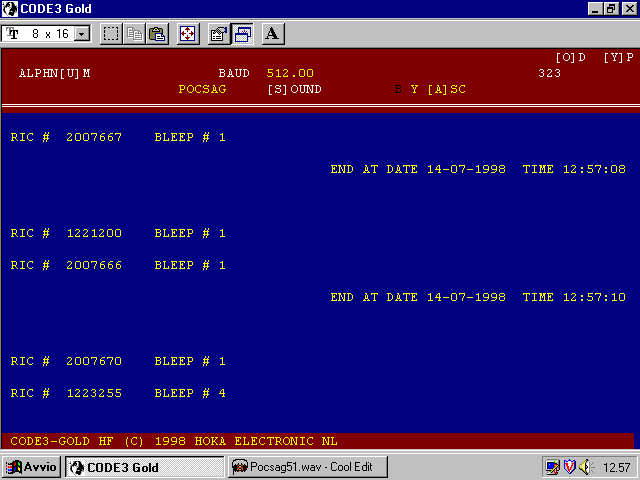Il sistema POCSAG (Post Office Standard Advisory Group) viene utilizzato da diversi servizi postali e telefonici per il servizio di cercapersone, in Italia č conosciuto come Teledrin. Questo modulo č perfettamente conforme alle disposizioni CCIR racc. 584 annex rec. 900. Il sistema di correzione d'errore BCH permette di correggere pių di due errori in ogni blocco di dati, e quando si verificano pių di due errori per ogni blocco di dati, il sistema salta la fase di correzione e si prepara a ricevere una nuova sequenza valida. Molte stazioni utilizzano l'invio due falsi errori per portare il sistema pager che riceve in posizione di riposo 'sleep'.
POCSAG / SUPER POCSAG
Pocsag is described in CCIR rec. 584-1 annex rec. 900. This module fully complies with these recommendations. The BCH error correction system is designed to correct up to 2 errors in each data block. If more than 2 consecutive error-blocks are detected then the system will immediately drop further decoding of the data block and wait for a new valid call. Many stations force two false errors at the end of their transmissions to instruct battery powered pagers to switch back to 'sleep' mode. Although the original specification was for a 512bps system, there has been further speeds added over the years to increase the number of pages/minute. Besides 512bps there is also 1200 and 2400bps observed. 1200bps and 2400bps is called Super Pocsag.
The majority of pager transmissions today are at 1200bps. 512bps is slowly being phased out in favour of the faster speeds. When receiving 1200 and 2400bps pager transmissions it is usually possible to decode most pages without modification to your scanner or receiver. You may be able to use the normal headphone or "rec out" socket. However, if you wish to decode all POCSAG transmissions you will need to take a tap off your receivers FM Discriminator. This is becuase the signal is a DC keyed transmission. It may make audio burbling type sounds, but the modulation is NOT applied to a normal FM or AM transmitter as with other VHF transmissions. POCSAG transmitters actually use a +/- 4kHz deviation. I.e if a transmitter was on a nominal frequency of 153.125 MHz then the two states would be 153.121 MHz and 153.129 MHz. It is quite feasible for a transmitter to need to send the sequence 1111111 or 000000 and this would result in a signal that appeared to be temporarily "resting" on one frequency. If you monitor the D.C. voltage on the output of a discriminator using a high impedance device such as an oscilloscope you would see square shaped waves coming out whenever the signal keyed its binary data stream. If you now monitor the same signal via the headphone or "rec-out" socket you would see something which was a lot different! All the steady +/- 4kHz states would decay very quickly over a very short time such that what should be 1111111 becomes 111 "dunno" "dunno" "dunno" "dunno". This very much reminds me of that old expression "GIGO" (Garbage in Garbage Out).
